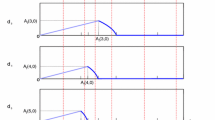Summary and Conclusions
The irradiation time and the dose per fraction are two key parameters in the fractionated therapy of patients with cancer. Reduction of the total treatment time and the use of low doses per fraction lead to improvements in the therapeutic relationship in cancer of the head and neck and at other tumour localisations of epithelial origin. The introduction of the linear-quadratic model and the biologically effective dose concept into the clinical setting has enabled quantitative analysis of the biological effects of radiation on malignant tumours and on acutely and slowly responding tissues, notably enhancing the perception of relationships between basic phenomena and clinical data. As a result, new and better irradiation regimens have been developed for the treatment of patients with specific tumours.
Similar content being viewed by others
Recommended references
Baclesse F. Clinical experience with ultrafractionated radiotherapy. Progress in radiation therapy. New York: Grune Stratton; 1958. p. 128–48.
Barendsen GW. Dose fractionation, dose rate and isoeffect relationships for normal tissue response. Int J Radiat Oncol Biol Phys 1982;8:1982–97.
Coutard H. Roentgentherapy of epitheliomas of the tonsillar region, hypopharynx and larynx from 1920 to 1926. Am J Roentgenol 1932;28:313–31.
Elkind MM, Sutton H. X-ray damage and recovery in mammalian cells in culture. Nature 1959;184:1293–5.
Ellis F. Dose, time and fractionation. A clinical hypothesis. Clin Radiol 1969;20:1–7.
Fowler JF. The linear-quadratic formula and progress in fractionated radiotherapy. Br J Radiol 1989;62:679–84.
Hall EJ. Time, dose and fractionation in radiotherapy. En: Hall EJ, editor. Radiobiology for the radiologist. 5.a ed. Philadelphia: Lippincott Williams Wilkins; 2000. p. 397–418.
Joiner MC, van der Kogel AJ. The linear-quadratic approach to fractionation and calculation of isoeffect relationships. En: Steel GG, editor. Basic Clinical Radiobiology. London: Arnold; 1997. p. 106–22.
Paterson R. The treatment of malignant disease by radiotherapy. Baltimore: Williams Wilkins; 1963.
Puck TT, Markus PI. Actions of X-rays on mammalian cells. J Exp Med 1956;103(5):653–66.
Strandqvist M. Studien uber die kumulative wirkung der roentgenstrahlen bei fractionierung. Acta Radiol (Stockholm) 1944; Suppl 55:1–300.
Withers HR. Biological basis for altered fractionation schedules. Cancer 1985;55:2086–95.
Withers HR. Radiation biology and treatment options in radiation oncology. Cancer Res 1999;59:1676–84.
Withers HR, McBride W. Radiation effects on normal tissues. Front Radiat Ther Oncol 1999;32:1–8.
Withers HR, Taylor JMG, Maciejewski B. The hazard of accelerated tumour clonogen repopulation during radiotherapy. Acta Oncol 1988;27:131–46.
Author information
Authors and Affiliations
Corresponding author
Rights and permissions
About this article
Cite this article
Muriel, V.P. Dose-time relationships in fractionated radiotherapy for cancer. Rev Oncol 5, 49–54 (2003). https://doi.org/10.1007/BF02712843
Published:
Issue Date:
DOI: https://doi.org/10.1007/BF02712843




